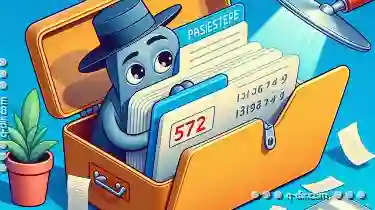When you copy content from one location and paste it into another, the act of pasting can often involve more than just transferring text or files. In ...
 certain scenarios, what might initially seem like a simple cut-and-paste operation is actually creating a link between the source and destination. Understanding when this occurs and why it matters can greatly enhance your productivity and data management strategies.
certain scenarios, what might initially seem like a simple cut-and-paste operation is actually creating a link between the source and destination. Understanding when this occurs and why it matters can greatly enhance your productivity and data management strategies.1. What Happens During a Paste Operation?
2. When a Paste Becomes a Link: What You Need to Know
3. Why Does It Matter?
4. Conclusion: Smart Operations with Your Digital Assets
1.) What Happens During a Paste Operation?
Before diving into the nuances of pasting links, let's briefly review what happens during a standard paste operation:
- Copying: You select the content you want to move (e.g., text, files).
- Cutting: If you use the cut command, the selected content is removed from its original location and placed in the clipboard.
- Pasting: The content is then retrieved from the clipboard and inserted into the desired destination. In many applications, this can be done directly by right-clicking and selecting 'Paste' or using keyboard shortcuts like Ctrl+V (Windows) or Command+V (Mac).
2.) When a Paste Becomes a Link: What You Need to Know
1. Linking vs. Copying
When you paste content into another location, if the destination allows for it (like in some text editors or software that supports links), you might create what is essentially an 'alias' to the original file or document. This means changes made to the linked item will be reflected in both places.
2. Platform and Application Behavior
The behavior of pasting as a link can vary significantly across different platforms, applications, and software tools:
- Operating Systems: Windows often treats pasted text differently depending on its format (plain text vs. rich text). Rich text might interpret certain characters or sequences to create hyperlinks automatically.
- Software Applications: Specific programs may have settings that dictate whether content is linked or copied upon pasting. For example, in Microsoft Word, you can choose between 'Keep Source Formatting' and 'Merge Formatting'. If set to merge, parts of the text might be linked depending on how they were formatted (like hyperlinks).
- Web Applications: Many web browsers allow users to create links by simply copying content and pasting it into a URL bar or an input field where URLs can be recognized.
3. Intentional vs. Unintentional
It's important to distinguish between intentional actions (such as creating hyperlinks) and unintended consequences of paste operations:
- Intentional Linking: Sometimes, you might intentionally create links when pasting by using specific formatting or commands that tell the application to treat the content as a link. This is often seen in tasks like setting up bookmarks in web browsers or inserting citations with clickable URLs in documents.
- Unintentional Link Creation: Errors can occur during copying and pasting where characters are misinterpreted, leading to unintended links being created without explicit commands (e.g., some special characters might trigger URL recognition).
3.) Why Does It Matter?
1. Organization and Accessibility
Links created by paste operations can be very useful for organization purposes:
- Quick Access: Hyperlinks allow you to access information quickly from different locations without needing to navigate through multiple steps or files.
- Data Integrity: Linked content ensures that modifications made in one place are reflected across all linked instances, which is crucial for maintaining consistency and avoiding duplication of effort.
2. File Management
For file managers and storage applications, understanding when a paste operation creates a link can affect how files are managed:
- Space Utilization: Direct copying uses disk space twice (in both locations), while linking does not increase the footprint unless changes are made to the linked item.
- Synchronization Needs: If you frequently update content in one place and want those updates reflected everywhere, using links can be more efficient than duplicating files.
3. Collaboration and Version Control
In collaborative environments where multiple users access or modify shared documents:
- Real-Time Updates: Links ensure that all collaborators see the most up-to-date version of a document or file without each having to manually update it themselves.
- Version Tracking: Changes in linked content can be tracked more effectively, which is beneficial for maintaining accurate historical records and resolving conflicts if multiple users edit the same item simultaneously.
4.) Conclusion: Smart Operations with Your Digital Assets
Understanding when pasting actions create links or copies can significantly improve how you manage your digital assets across various platforms and applications. Whether through intentional actions like setting up hyperlinks or through awareness of unintended consequences, knowing these nuances allows for more efficient workflows and better data management practices. By recognizing the differences between direct copying and link creation in paste operations, you can make informed decisions that optimize accessibility, organization, and collaboration-benefiting both your personal use and professional work environments.

The Autor: / 0 2025-03-12
Read also!
Page-

How Tree View Could Bridge the Gap Between Old and New UI
One particularly effective tool that has proven its worth in this regard is the tree view. This blog post will explore how tree views can serve as an ...read more

How to Recover Files with Corrupted Filenames
File management is an essential part of our digital lives, and filenames play a crucial role in organizing and accessing files efficiently. However, ...read more

How to Paste Files into a Hidden Folder
One of the lesser-known yet powerful features of many operating systems is the ability to paste files into hidden folders. This method not only helps ...read more